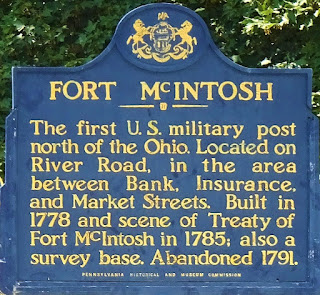I almost don't dare to believe it, but we managed to get through pretty much the entire month of March without any snow (or at least, any snow accumulation). We even had some actual springlike weather! April is just around the bend, and with the days getting longer, I think the worst of winter really is behind us at last.
Time to add another name to the list of guest photographers, and it's someone I hadn't anticipated when the blog began! John Robinson is retired from the PHMC itself, and has been kind enough to send me my first (of many, I hope) marker from Beaver County. This particular landmark actually has several markers for it, as I discovered when I went to the Historic Marker Database to look for it, but only one was erected by the PHMC so that's the one in today's post. Let's pay a long-distance visit to a garrison of the American Revolution - a very important one, in fact.
 |
| The marker stands at the intersection of Third and Insurance Streets, less than a mile from where the fort was. Image courtesy of John Robinson. |
Lachlan McIntosh is primarily famous for two things. One is his military record, including the fort of today's quest; the other is his duel with a man named Button Gwinnett. Yes, that was his real name. They were major political rivals, being on opposite sides of a movement in Georgia regarding loyalty to Britain, and McIntosh took over Gwinnett's role as commander of Georgia's Continental Battalion in 1776. Gwinnett went on to the Continental Congress, and signed the Declaration of Independence, but he came back to Georgia as a high-ranking political figure and had a number of altercations with McIntosh. (Among other things, he had George McIntosh - one of Lachlan's brothers - arrested on charges of treason.) McIntosh denounced Gwinnett to the Georgia assembly, which led Gwinnett to call for the duel, and they met in the spring of 1777 to fire musket balls at each other. They each took an injury to the leg, but while McIntosh recovered, Gwinnett died three days later. McIntosh was charged with murder for this, but acquitted at trial. This led to George Washington getting involved, directing McIntosh to report to Pennsylvania, because he was worried that Gwinnett's friends might seek revenge.
In 1778, McIntosh was made Major General of the Western Department of the Continental Army, which is quite the mouthful, and sent to Fort Pitt in what is today Pittsburgh. From there, he began restoring order and establishing forts to help defend the western border of the commonwealth. One of these was, as might be expected, Fort McIntosh, which was situated in the modern-day community of Beaver. It sat along the Ohio River, near what is now the intersection of River Road and Insurance Street, and its former position is today marked by several markers describing the structure. This one, in particular, gives the shape of the building and a sense of its scale, as well as describing it as being made of square-hewn logs arranged on a stone foundation. Fort McIntosh was the very first fort completed by the Continental Army north of the Ohio River, and in the words of the Beaver Area Heritage Foundation, it was "the headquarters of the largest army to serve west of the Alleghenies." Its garrison of roughly 1,500 men defended the western frontier from potential attacks by British soldiers and raids by their Native American allies.
 |
| The site of Fort McIntosh today (click for larger view). Image courtesy of John Robinson. |
As for Lachlan McIntosh, whose name still adorns the site, he was replaced as Commander of the Western Department in 1779 by Colonel Daniel Brodhead, and followed Washington's orders to assist the forces in South Carolina. Although he was successful in helping with the siege of Savannah, Georgia, he was taken prisoner when Charleston was surrendered in 1780, and remained captive for nearly two years until he was released in a prisoner exchange. After the Peace of Paris ended the war in 1783, McIntosh returned to his southern plantation only to find it had been ransacked by the British; he attempted to restore it, with little success. He was employed to intercede with southern Native American tribes on behalf of the new government, and was part of the delegation who welcomed President Washington to Georgia in 1791. He died in Savannah on February 20, 1806, and is buried in the city's historic Colonial Park Cemetery. Georgia's McIntosh County is named in honor of him and other members of his family who served in the military during assorted wars.
Incidentally, McIntosh's wife Sarah died in 1814, but I can't find any record of her burial. If anyone out there can tell me where she is, please leave a comment. I'd like to connect her to her husband on FindAGrave.com if I can!
Many thanks to John Robinson for his contributions to this quest! If you also want to be a guest photographer on the blog, click on the link at the top for "Questions, Questions" and read what to do.
Sources and Further Reading:
Except where indicated, all writing and photography on this blog is the intellectual property of Laura Klotz. This blog is written with permission of the Pennsylvania Historical and Museum Commission. I am not employed by the PHMC. All rights reserved.

No comments:
Post a Comment
I would love to hear from you!